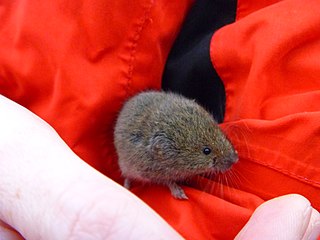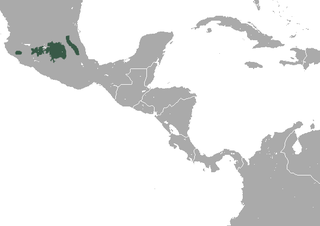| Actinothrips | |
|---|---|
| Scientific classification | |
| Kingdom: | Animalia |
| Phylum: | Arthropoda |
| Class: | Insecta |
| Order: | Thysanoptera |
| Family: | Phlaeothripidae |
| Genus: | Actinothrips Bagnall, 1909 |
Actinothrips is a genus of thrips in the family Phlaeothripidae. [1]
| Actinothrips | |
|---|---|
| Scientific classification | |
| Kingdom: | Animalia |
| Phylum: | Arthropoda |
| Class: | Insecta |
| Order: | Thysanoptera |
| Family: | Phlaeothripidae |
| Genus: | Actinothrips Bagnall, 1909 |
Actinothrips is a genus of thrips in the family Phlaeothripidae. [1]

Sex is the trait that determines whether a sexually reproducing animal or plant produces male gametes or female ones. Male plants and animals produce smaller gametes while females produce larger ones. Organisms that produce both types of gametes are called hermaphrodites. During sexual reproduction, male and female gametes fuse to form zygotes, which develop into offspring that inherit traits from each parent.

The Amazon rainforest, Amazon jungle or Amazonia is a moist broadleaf tropical rainforest in the Amazon biome that covers most of the Amazon basin of South America. This basin encompasses 7,000,000 km2 (2,700,000 sq mi), of which 5,500,000 km2 (2,100,000 sq mi) are covered by the rainforest. This region includes territory belonging to nine nations and 3,344 formally acknowledged indigenous territories.

An invasive species is an introduced organism that becomes overpopulated and harms its new environment. Although most introduced species are neutral or beneficial with respect to other species, invasive species adversely affect habitats and bioregions, causing ecological, environmental, and/or economic damage. The term can also be used for native species that become harmful to their native environment after human alterations to its food web – for example the purple sea urchin which has decimated kelp forests along the northern California coast due to overharvesting of its natural predator, the California sea otter. Since the 20th century, invasive species have become a serious economic, social, and environmental threat.

Tilapia is the common name for nearly a hundred species of cichlid fish from the coelotilapine, coptodonine, heterotilapine, oreochromine, pelmatolapiine, and tilapiine tribes, with the economically most important species placed in the Coptodonini and Oreochromini. Tilapia are mainly freshwater fish inhabiting shallow streams, ponds, rivers, and lakes, and less commonly found living in brackish water. Historically, they have been of major importance in artisanal fishing in Africa, and they are of increasing importance in aquaculture and aquaponics. Tilapia can become a problematic invasive species in new warm-water habitats such as Australia, whether deliberately or accidentally introduced, but generally not in temperate climates due to their inability to survive in cold water.

Chinchillas are either of two species of crepuscular rodents of the parvorder Caviomorpha. They are slightly larger and more robust than ground squirrels, and are native to the Andes mountains in South America. They live in colonies called "herds" at high elevations up to 4,270 m (14,000 ft). Historically, chinchillas lived in an area that included parts of Bolivia, Peru, Argentina, and Chile, but today, colonies in the wild are known only in Chile. Along with their relatives, viscachas, they make up the family Chinchillidae. They are also related to the chinchilla rat.

Psilocybin mushrooms, commonly known as magic mushrooms, are a polyphyletic informal group of fungi that contain psilocybin which turns into psilocin upon ingestion. Biological genera containing psilocybin mushrooms include Copelandia, Gymnopilus, Inocybe, Panaeolus, Pholiotina, Pluteus, and Psilocybe. Psilocybin mushrooms have been and continue to be used in indigenous New World cultures in religious, divinatory, or spiritual contexts. Psilocybin mushrooms are also used as recreational drugs. They may be depicted in Stone Age rock art in Africa and Europe, but are most famously represented in the Pre-Columbian sculptures and glyphs seen throughout North, Central and South America.

The Pholcidae are a family of araneomorph spiders. The family contains over 1,800 individual species of pholcids, including those commonly known as cellar spider, daddy long-legs spider, carpenter spider, daddy long-legger, vibrating spider, gyrating spider, long daddy, and skull spider. The family, first described by Carl Ludwig Koch in 1850, is divided into 94 genera.

The Bavarian pine vole is a vole from the Austrian, Italian, and Bavarian Alps of Europe. It lives in moist meadows at elevations of 600 to 1,000 meters. There are 23 museum specimens of this species. This rodent was previously known to live in only one location, Garmisch-Partenkirchen in Bavaria, which was altered by the construction of a hospital in the 1980s. No specimens of this rodent were recorded after 1962 and it was thought to be extinct. However, a population apparently belonging to this species was discovered in 2000 in Northern Tyrol, just across the German-Austrian border. An Austrian scientist, Friederike Spitzenberger, stumbled upon the species in a live trap. Its species status was confirmed by genetic studies, and it was found to be very closely related to Liechtenstein's vole from the Eastern Alps. Further research is required to determine the size and range of the population and the species has been re-assessed as Critically Endangered by the IUCN.

Male is the sex of an organism that produces the gamete known as sperm, which fuses with the larger female gamete, or ovum, in the process of fertilization.
The Catalogue of Life is an online database that provides an index of known species of animals, plants, fungi, and microorganisms. It was created in 2001 as a partnership between the global Species 2000 and the American Integrated Taxonomic Information System. The Catalogue interface is available in twelve languages and is used by research scientists, citizen scientists, educators, and policy makers. The Catalogue is also used by the Biodiversity Heritage Library, the Barcode of Life Data System, Encyclopedia of Life, and the Global Biodiversity Information Facility. The Catalogue currently compiles data from 168 peer-reviewed taxonomic databases that are maintained by specialist institutions around the world. As of June 2021, the Catalogue lists 1,997,284 of the world's 2.2m extant species known to taxonomists on the planet at present time.

A species that is extinct in the wild (EW) is one that has been categorized by the International Union for Conservation of Nature as known only by living members kept in captivity or as a naturalized population outside its historic range due to massive habitat loss.
The Ethiopian long-eared bat or Ethiopian big-eared bat is a recently described species of long-eared bat in the family Vespertilionidae.

The tree bat is a species of bat in the family Phyllostomidae and the only species in the genus Ardops. It is found in Dominica, Guadeloupe, Martinique, Montserrat, Netherlands Antilles, Saint Lucia, Saba and Saint Vincent and the Grenadines.

The Central Mexican broad-clawed shrew is a species of mammal in the family Soricidae. It is found in the highlands above 2000 m in the Mexican states of Colima, Hidalgo, Jalisco, Michoacán, Mexico, and Puebla, Morelos, and in the Mexican Federal District

Female is the sex of an organism that produces the large non-motile ova, the type of gamete that fuses with the male gamete during sexual reproduction.

The Valais shrew is a species of mammal in the family Soricidae.
Hyocephalidae are a small family of Heteroptera which are endemic to Australia.
The World Spider Catalog (WSC) is an online searchable database concerned with spider taxonomy. It aims to list all accepted families, genera and species, as well as provide access to the related taxonomic literature. The WSC began as a series of individual web pages in 2000, created by Norman I. Platnick of the American Museum of Natural History. After Platnick's retirement in 2014, the Natural History Museum of Bern (Switzerland) took over the catalog, converting it to a relational database.
Sato's beaked whale is a little-known species of four-toothed whale.